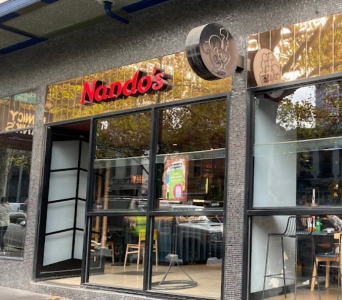Outrage over Nando's item sold for as low as 30 cents each at Coles: ‘Blatant rip-off’
When you're craving a juicy burger from Nando's, the last thing you want to worry about is the cost of adding a slice of cheese.
However, a recent revelation by a disgruntled customer has sparked a debate about the pricing strategies of popular food chains.
The customer, who remained anonymous, shared his shock after being charged an additional $2.95 for a slice of cheddar cheese on his $14.95 PERinaise Classic burger ordered via Uber Eats.

The customer expressed his outrage, stating, '[It’s] still a blatant rip-off when a slice of cheese from [the grocery store] would cost at most 10 cents, let alone wholesale prices.'
‘There’s no justification for such significant profit margins when the cost of living is so high. Unfortunately, cheese is a necessity for many burger eaters like myself.’
He further added that he would consider bringing his own cheese from home to avoid the 'ridiculous prices'.
To put things into perspective, a packet of 12 cheese slices at Coles or Woolworths costs as little as $3.50, which equates to around 30 cents per slice. This stark price difference has left many customers questioning the fairness of such pricing strategies.
While it's common knowledge that delivery services often inflate prices compared to in-store orders to account for operation costs, Nando's website reveals that even direct orders incur a $1.95 charge for adding cheese.
Flinders University Professor of Business Management Roberta Crouch explained that Nando's employs an age-old pricing strategy.
According to her, businesses often advertise their core product at a low price, only to 'supercharge' the cost of extras. This strategy is not unique to Nando's; budget airlines, for instance, advertise cheap flights but then charge customers a hefty amount to add luggage.
Crouch argued that while this strategy allows for consumer choice, it can be seen as a bit of a 'dirty pool' when the extras are readily available and inexpensive items, like cheese.
'There’s no cheese shortage. Cheddar cheese for a restaurant is very cheap. They’d be buying that super cheap, and they know that it’s a typical thing that people want on their food that would cost them a few cents, and it allows them to put an extra $3 on the price,' Ms Crouch explained.
‘I think what these organisations are doing is quite outrageous because it allows them to advertise a meal at a price that isn’t really representative of what the meal is going to cost,’ she also stated.
Ms Crouch also mentioned that inflationary pressures are impacting prices.
‘Insurance, wages, electricity, rates and taxes, costs of produce—everything is more expensive. Businesses, especially small and medium-sized businesses, are under enormous pressure,’ she added.
As of publishing, Nando's Australia has not provided any comment on the issue.
While the Nando's cheese charge may seem outrageous, it's not an isolated incident. Many restaurants and food chains employ similar pricing strategies, charging extra for add-ons that seem trivial.
Recently, a diner expressed outrage over a $3.50 restaurant surcharge for an item that can be bought at Coles for a dollar. You can read more about that story here.
This practice, often referred to as 'nickel and diming', can significantly inflate the final bill, leaving customers feeling cheated.
For instance, some restaurants charge extra for bread and butter, a side of sauce, or even a glass of tap water. While these charges may seem small individually, they can add up quickly, especially when dining out with a group.
It's always a good idea to carefully review the menu for any additional charges related to substitutions or extras. If you are unsure, don't hesitate to ask the staff for clarification.
While it's unlikely that restaurants will change their pricing strategies anytime soon, being aware of these hidden costs can help you make more informed decisions when dining out.

What's your take on this, members? Have you ever been hit with a surprising charge at a restaurant? Share your experiences in the comments below.
However, a recent revelation by a disgruntled customer has sparked a debate about the pricing strategies of popular food chains.
The customer, who remained anonymous, shared his shock after being charged an additional $2.95 for a slice of cheddar cheese on his $14.95 PERinaise Classic burger ordered via Uber Eats.

A customer revealed that Nando’s charges $2.95 for an extra cheese slice. Image source: Kat & Dav Adventures/Google
The customer expressed his outrage, stating, '[It’s] still a blatant rip-off when a slice of cheese from [the grocery store] would cost at most 10 cents, let alone wholesale prices.'
‘There’s no justification for such significant profit margins when the cost of living is so high. Unfortunately, cheese is a necessity for many burger eaters like myself.’
He further added that he would consider bringing his own cheese from home to avoid the 'ridiculous prices'.
To put things into perspective, a packet of 12 cheese slices at Coles or Woolworths costs as little as $3.50, which equates to around 30 cents per slice. This stark price difference has left many customers questioning the fairness of such pricing strategies.
While it's common knowledge that delivery services often inflate prices compared to in-store orders to account for operation costs, Nando's website reveals that even direct orders incur a $1.95 charge for adding cheese.
Flinders University Professor of Business Management Roberta Crouch explained that Nando's employs an age-old pricing strategy.
According to her, businesses often advertise their core product at a low price, only to 'supercharge' the cost of extras. This strategy is not unique to Nando's; budget airlines, for instance, advertise cheap flights but then charge customers a hefty amount to add luggage.
Crouch argued that while this strategy allows for consumer choice, it can be seen as a bit of a 'dirty pool' when the extras are readily available and inexpensive items, like cheese.
'There’s no cheese shortage. Cheddar cheese for a restaurant is very cheap. They’d be buying that super cheap, and they know that it’s a typical thing that people want on their food that would cost them a few cents, and it allows them to put an extra $3 on the price,' Ms Crouch explained.
‘I think what these organisations are doing is quite outrageous because it allows them to advertise a meal at a price that isn’t really representative of what the meal is going to cost,’ she also stated.
Ms Crouch also mentioned that inflationary pressures are impacting prices.
‘Insurance, wages, electricity, rates and taxes, costs of produce—everything is more expensive. Businesses, especially small and medium-sized businesses, are under enormous pressure,’ she added.
As of publishing, Nando's Australia has not provided any comment on the issue.
While the Nando's cheese charge may seem outrageous, it's not an isolated incident. Many restaurants and food chains employ similar pricing strategies, charging extra for add-ons that seem trivial.
Recently, a diner expressed outrage over a $3.50 restaurant surcharge for an item that can be bought at Coles for a dollar. You can read more about that story here.
This practice, often referred to as 'nickel and diming', can significantly inflate the final bill, leaving customers feeling cheated.
For instance, some restaurants charge extra for bread and butter, a side of sauce, or even a glass of tap water. While these charges may seem small individually, they can add up quickly, especially when dining out with a group.
It's always a good idea to carefully review the menu for any additional charges related to substitutions or extras. If you are unsure, don't hesitate to ask the staff for clarification.
While it's unlikely that restaurants will change their pricing strategies anytime soon, being aware of these hidden costs can help you make more informed decisions when dining out.
Key Takeaways
- A Nando's customer expressed outrage over being charged nearly $3 for adding cheese to a burger on Uber Eats, considering it a ‘rip-off’.
- Professor Roberta Crouch warned that high charges for add-ons have become commonplace in various businesses, although customers find them unjustified.
- She explained that the pricing strategy involves advertising the core product at a low price but supercharging prices for extras.
- Inflationary pressures and the rising costs of running a business are also contributing to the increase in prices for added items.
What's your take on this, members? Have you ever been hit with a surprising charge at a restaurant? Share your experiences in the comments below.







